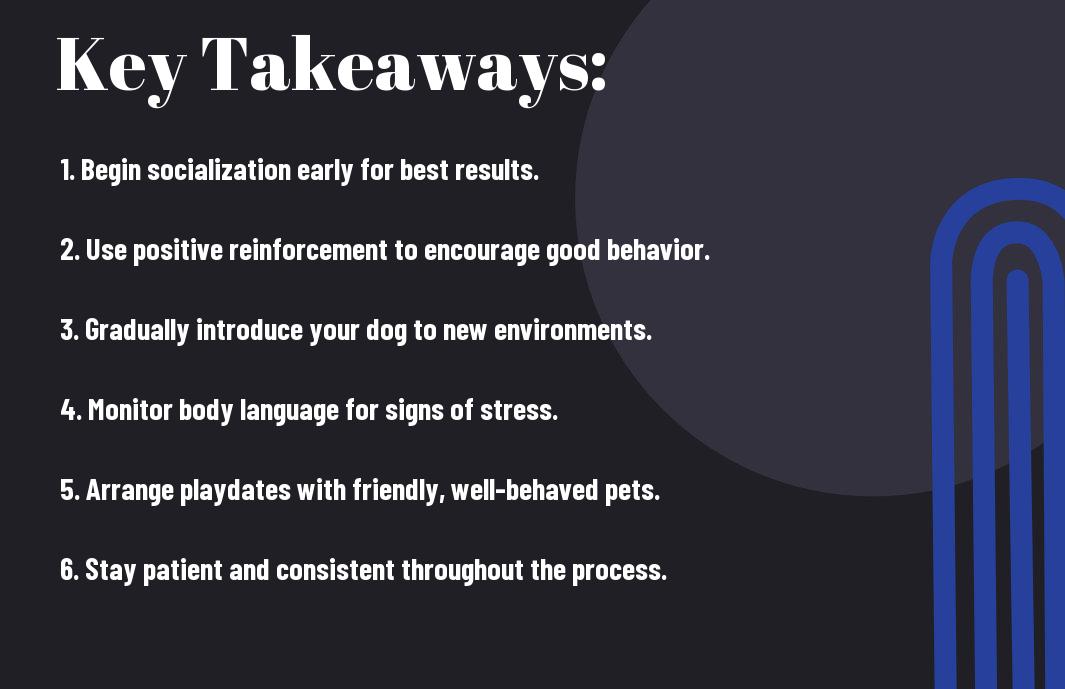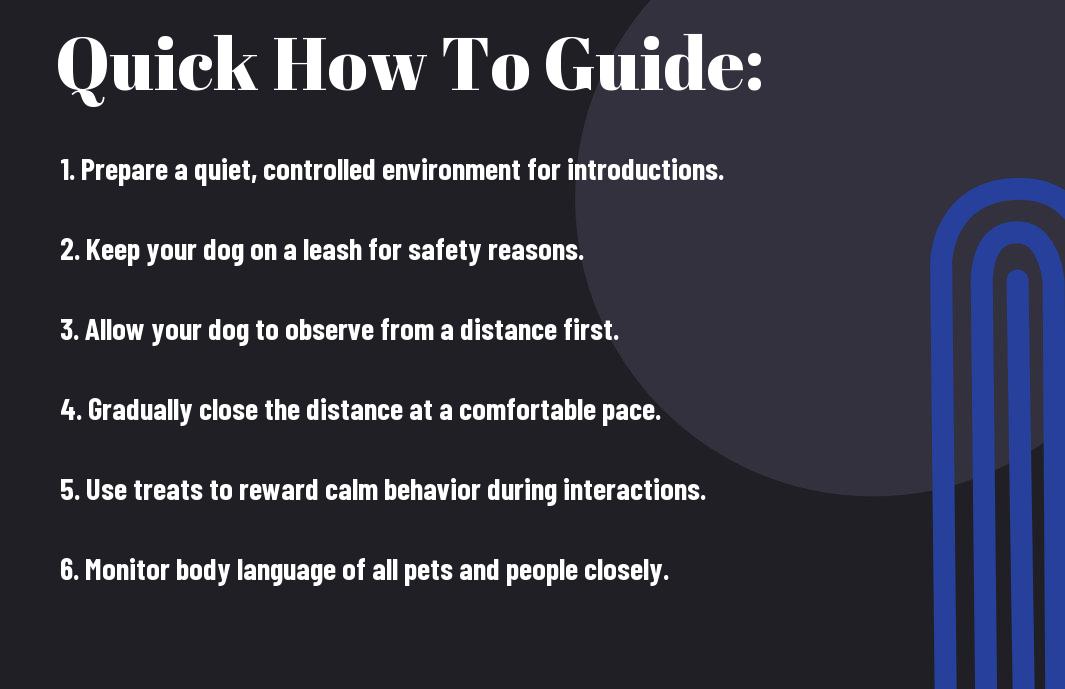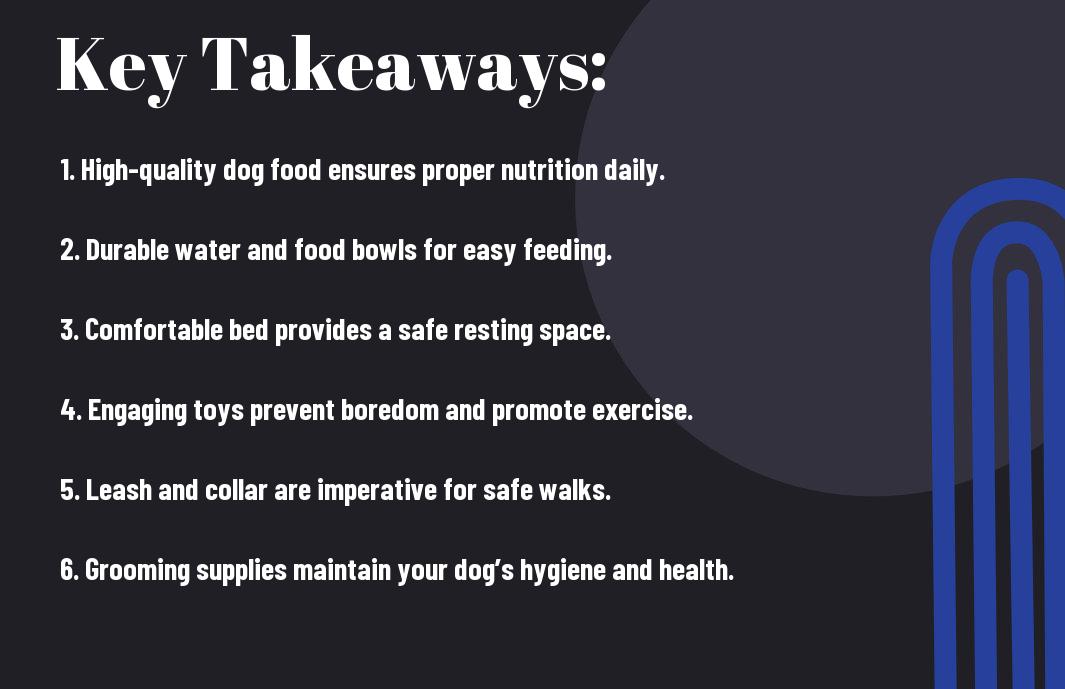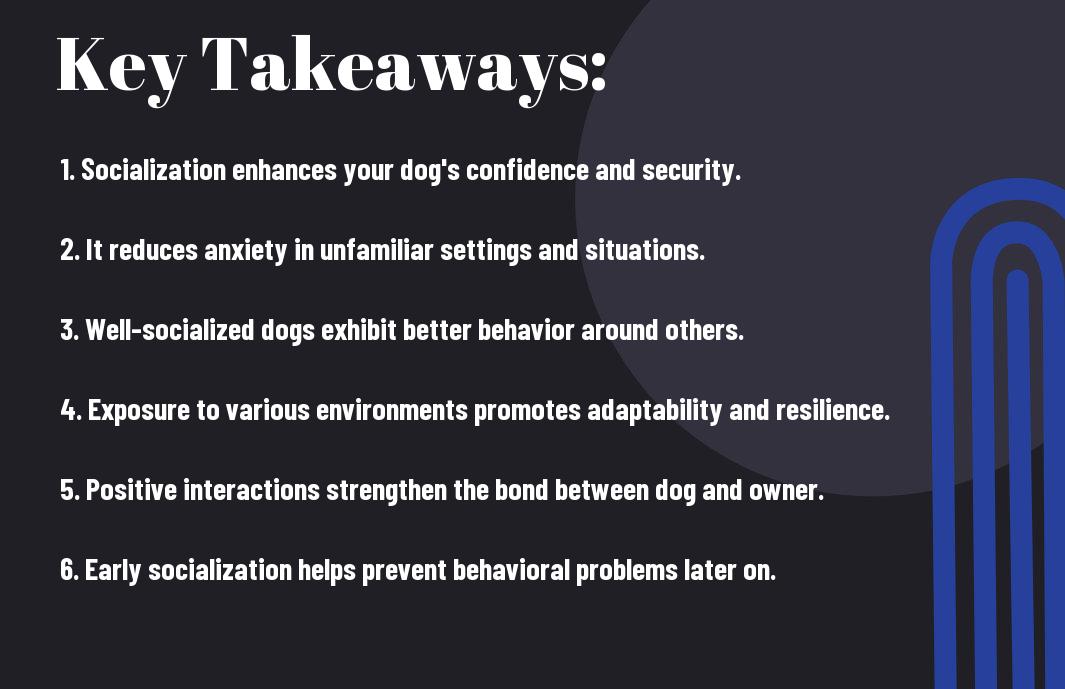Just like humans, your dog thrives on social interaction, which enhances their overall well-being. Whether you’re introducing your furry friend to other pets or new people, the right approach can make all the difference. To ensure positive experiences, gradual introductions, rewarding good behavior, and monitoring body language are imperative. By applying these tips, you can help your dog become more confident and well-adjusted in different social settings, leading to a happier life for both of you.


Understanding Canine Behavior
Before you can effectively socialize your dog, it is imperative to have a solid understanding of canine behavior. Every dog has its unique personality, influenced by factors such as breed, socialization history, and individual experiences. Identifying the nuances of your dog’s behavior will provide valuable insights into how they might react to new situations, other pets, and strangers. By recognizing these traits, you’ll be better equipped to manage introductions and interactions in a way that is safe and positive for everyone involved.
Canine Body Language
Before venturing into dog socialization techniques, it is vital to understand how to read canine body language. Dogs communicate through a complex system of signals that convey their feelings and intentions. For instance, a wagging tail may indicate excitement or happiness, but the position and speed of the wag can change the message. Additionally, a dog that avoids eye contact, tucks its tail, or retreats may feel threatened or uncomfortable. Learning to decode these signals can help you modify your approach to socialization.
Common Dog Behaviors
On another note, familiarizing yourself with common dog behaviors can help set realistic expectations during socialization. Each dog reacts differently; while some may be naturally outgoing and welcoming, others might be shy or protective of their space. Understanding that these differences exist will allow you to tailor your interactions accordingly. For example, an overly exuberant dog may inadvertently overwhelm a more reserved one. Observing these behaviors will be beneficial as you navigate social scenarios such as dog parks, meet-and-greets, or group classes.
For instance, barking, growling, or even a stiff body posture can indicate that a dog is feeling defensive or anxious. Pay attention to your dog’s cues as well as those from other dogs and people around you. Recognizing these behaviors can prevent misunderstandings and potential conflicts, ensuring a smoother socialization process for you and your dog.
Understanding Socialization
Understanding the concept of socialization is vital for your dog’s well-being. Socialization involves exposing your dog to various environments, people, and other animals in a controlled manner, helping them develop positive associations with new experiences. Your goal is to prevent fear or aggression by helping your dog become accustomed to different situations while fostering trust and confidence. This is often best achieved during a dog’s early developmental stages but can also be beneficial at any age.
To effectively socialize your dog, you must gradually introduce them to new experiences. Begin with more controlled settings, like introductions to calm, friendly pets or gentle people who understand dog behavior. As your dog grows more comfortable, you can progressively expose them to more challenging situations. Keeping interactions positive and rewarding will reinforce their confidence, making them better equipped for future encounters.
Preparing for Socialization
The process of preparing your dog for socialization is vital to ensure that both you and your dog experience positive interactions with other pets and people. This preparation includes gathering the necessary supplies, selecting the right environment, and assessing your dog’s temperament. By taking these steps, you can help your dog become more comfortable and confident during socialization experiences.
Essential Supplies for Socializing
Socialization starts with having the right supplies at your disposal. Consider investing in a quality leash and collar or a harness that allows for good control of your dog during interactions. You might also want to have some treats handy to reward positive behavior and create a positive association with social encounters. Additionally, a comfortable crate can provide your dog with a cozy retreat when they feel overwhelmed.
Another fundamental item is a muzzle if you believe there is a chance your dog may react aggressively or if there are specific circumstances where it might be necessary. This tool should only be used to enhance safety and not as a substitute for training. Having a first-aid kit at home and knowledge of basic dog behavior can also be beneficial.
Choosing the Right Environment
At the beginning of your dog’s socialization journey, selecting the right environment is vital to ensure stress levels are minimized. Consider starting in low-distraction areas, such as your backyard or a quiet park, where your dog can gradually acclimate to the presence of other pets and people. You can gradually introduce your dog to more stimulating environments, like dog-friendly parks, once they show comfort and confidence in quieter settings.
Consequently, be conscious of your dog’s reactions to different environments. If they appear anxious, it’s better to step back and choose a less overwhelming location for their socialization practice. The goal is to provide a safe space where you can gradually introduce your dog to different scenarios without overwhelming them.
Assessing Your Dog’s Temperament
Among the important steps in preparing your dog for socialization is understanding their temperament. Dogs have differing personalities, and some may naturally be more friendly and outgoing, while others might be shy or anxious. Take the time to observe how your dog reacts to new situations, unfamiliar sounds, and other animals. This assessment will help you tailor their socialization experiences to meet their specific needs.
Environment also plays a significant role in influencing your dog’s behavior. For instance, a calm environment may allow your timid dog to feel safe and open up, while a bustling, noisy area might agitate them. Ensuring that you know your dog’s temperament will help in choosing appropriately stimulating environments and social interactions that suit their individual comfort level.
Socializing with Other Dogs
Many dog owners understand the importance of socializing their pets with other animals, particularly dogs. Proper socialization helps your dog develop good manners and reduces the likelihood of aggressive behavior in unfamiliar situations. It is imperative to introduce your dog to different breeds, sizes, and ages of canines to facilitate a well-rounded social experience. This process starts gradually, allowing your dog to become comfortable in various environments where they might encounter other dogs.
Introducing to Adult Dogs
Behind every successful introduction to an adult dog lies careful and thoughtful planning. Begin in a neutral setting, such as a park or open area, where neither dog feels territorial. Observe body language and approach at a relaxed pace, allowing both dogs to sniff and assess one another from a distance. As they become more comfortable, you can allow for closer interactions. It’s vital to watch for signs of stress or aggression, such as growling or stiff tails, and to intervene promptly if needed.
Introducing to Puppies
With puppies, socialization is key to their overall development. Since puppies are generally more sociable and playful, the introduction process can often be a bit more straightforward. Choose a safe environment where your puppy can interact freely with other puppies. Use positive reinforcement, such as praise or treats, to encourage good behavior during play. Monitor their interactions closely to ensure they are enjoying the experience without becoming overly rambunctious or aggressive.
At this age, your puppy is learning important social skills, so interactions with well-mannered adult dogs can significantly benefit them. Ensure that adult dogs are tolerant and patient to provide appropriate guidance during play with your puppy. Also, avoid overwhelming your puppy; too many interactions at once may lead to stress or fear, which could hinder their socialization process in the future.
Managing Playtime and Interactions
Around other dogs, managing playtime effectively is imperative for ensuring that interactions remain positive. Supervise play sessions to ensure that both your dog and the other dogs are in a safe and enjoyable environment. Look out for signs of fatigue or stress in your dog, such as panting, seeking distance, or changes in tail posture. Establish a set duration for playtime and take breaks to allow everyone to recharge and avoid potential disputes.
With proper management of playtime, you can foster a positive atmosphere for socialization. This helps your dog learn to read other dogs’ cues and respond appropriately, creating opportunities for lasting friendships. Engaging in different activities, like fetch or walking together, also encourages healthy interactions while reducing the pressure of constant face-to-face encounters. Your vigilance and understanding during these interactions will lay the groundwork for healthy relationships between your dog and other pets.
Socializing with People
For the comfort and well-being of your dog, effectively socializing them with people is necessary. Engaging with various individuals not only helps your dog become well-rounded but also promotes positive behavior in different environments. By regularly introducing your dog to a diverse range of people, you can help reduce anxiety and increase their confidence. This process is all about fostering a friendly and welcoming atmosphere for your furry companion.
Gradual Introduction to New People
An effective way to socialize your dog with people is through a gradual introduction. Start by allowing your pet to observe new individuals from a distance where they feel comfortable. Gradually decrease the distance as your dog becomes more relaxed in the presence of these new people. Make sure to always prioritize your dog’s comfort level, ensuring they don’t feel overwhelmed or scared. You can also use calming tools, such as a favorite toy or blanket, to ease their anxiety during these encounters.
As your dog grows more accustomed to seeing new faces, you can start inviting friendly and calm individuals to interact with them. Encourage your guests to let your dog approach at their own pace, allowing them the opportunity to sniff and explore before any physical contact occurs. This slow, methodical approach helps build your dog’s confidence and reduces the chance of any negative reactions towards unfamiliar people.
Positive Reinforcement Techniques
On your journey to socializing your dog, one of the most effective methods is employing positive reinforcement techniques. This approach involves rewarding the behaviors you want to encourage, such as calmness or curiosity around new people. By using treats, praise, or playtime as rewards, you reinforce desirable behaviors and help your dog associate new people with positive experiences. Consistency is key here; make sure to reward your dog every time they display friendly and relaxed behavior during introductions.
For instance, when a new person approaches, use treats to reward your dog for remaining calm instead of barking or pulling. This positive reinforcement helps your dog learn that positive interactions lead to enjoyable outcomes. Gradually, you’ll see them develop a healthier response to new faces, becoming more confident and less fearful over time.
Handling Fearful or Aggressive Behavior
Between the excitement of socializing with various people, you may encounter instances where your dog displays fearful or aggressive behavior. It’s necessary to approach these situations with care and understanding. If your dog begins to show signs of fear—such as cowering, barking, or hiding—it’s important to create a safe space where they can retreat. Do not force interactions; instead, let your dog take the lead and come forward at their own pace. Always be attentive to their body language to better understand their comfort level.
Addressing aggressive reactions is equally important. If your dog reacts aggressively, it’s crucial to seek help from a professional trainer or behaviorist who can provide tailored strategies to manage and correct these behaviors. You should never punish your dog for fear or aggression, as this can worsen the issue. Instead, focus on building their confidence and trust through slow introductions and rewarding desired behaviors, ensuring everyone remains safe.
Introduction to a new world can be challenging for dogs showing signs of fear or aggression. By creating a structured plan that incorporates gradual introductions and positive reinforcement, you can help your dog overcome their insecurities and learn to respond more positively to new situations. Investing time and patience in this process can lead to a well-socialized dog that enjoys meeting and interacting with people.
Socialization with Other Pets
All dog owners know the importance of socializing their pets. Engaging with other pets not only boosts their confidence, but it also helps them develop healthy behaviors and communication skills. Proper socialization is imperative to reducing anxiety and potential aggression, ensuring that your dog can coexist peacefully with other animals. One area where many pet owners seek guidance is in the process of introducing their dog to other pets.
Introducing Cats to Dogs
By taking the right steps, you can facilitate a positive interaction between your cat and dog. Start by allowing them to become accustomed to each other’s scents. You can achieve this by swapping their bedding or toys, giving each pet the opportunity to explore the other’s aroma in a safe manner. When introducing them face-to-face, do so in a controlled environment. Keep your dog on a leash and allow the cat to retreat to a safe space if it feels threatened, ensuring that your dog remains calm and focused on you.
By remaining patient and observing their body language, you can gauge their comfort level. If your dog displays overly excited behavior, it’s important to redirect that energy to a more positive outlet, such as a toy or a treat. Gradually increase their time together, always at a pace that makes both pets feel secure. With proper guidance, your dog and cat can develop a harmonious relationship.
Socializing with Small Animals
Socializing your dog with small animals, such as rabbits, guinea pigs, or birds, can be a rewarding experience but does require caution. When introducing your dog to these smaller pets, *always* maintain a safe distance and ensure that your dog is on a leash. Allow your dog to observe the small animals from afar, rewarding calm behavior with treats and praise. It’s key to create positive associations so that your dog learns that these creatures are friends and not prey.
Socializing in a controlled environment also promotes safety and comfort for both your dog and the small animals involved. Never leave your dog alone with small pets until you are completely confident in their behavior. Gradually increase interaction time only when it is clear that your dog can remain calm and composed.
Also, each small animal has its own unique behavior. For instance, rabbits may freeze or thump in response to perceived danger. Familiarizing yourself with these signals can help you better understand how your dog might react. If your dog seems overly excitable or aggressive, it’s imperative to take a step back and revisit basic training before attempting further socialization.
Multi-Pet Household Dynamics
Cats and dogs can successfully coexist in a multi-pet household, but it often requires thoughtful planning and understanding of each pet’s needs. Recognize that the introduction process should be gradual, as both species have distinct social cues and behaviors that can conflict if not acknowledged. Create a space where all pets can feel safe and establish boundaries to reduce territorial disputes.
Managing the dynamics in a multi-pet household means being vigilant about assigning individual spaces or rooms. This allows each pet to retreat when they need a break, reducing stress and potential conflicts. A positive approach uses reward-based training to encourage good behavior amongst all pets, establishing a calm environment where socialization becomes easier.
With patience and observation, you’ll discover the nuances of pet interactions. Establishing clear communication between all animals helps them understand their place in the household, enhancing their bond with each other and reducing the chances of tension or aggression.

Ongoing Socialization Techniques
Once again, socializing your dog is not a one-time event but a continuous process that requires your active involvement. As your dog grows and encounters new situations, it is crucial to regularly engage them in experiences that foster their social skills. Consistently providing opportunities for your dog to interact with other pets and people will help ensure that they remain well-adjusted and comfortable in diverse environments.
Regular Outings and Exposure
An effective approach to ongoing socialization is to incorporate regular outings into your dog’s routine. Taking your dog on frequent trips to different places exposes them to a variety of sights, sounds, and smells that help broaden their understanding of the world. This can include visits to pet-friendly stores, outdoor cafes, or even just walks in different neighborhoods. The more varied their experiences are, the more adaptable and confident your dog will become in new situations.
Additionally, it’s crucial to gradually increase the level of exposure by introducing your dog to different types of environments, such as busy streets, parks, or crowded events. This helps your dog learn to cope with distractions and develop appropriate behaviors when faced with unexpected situations. Be attentive to your dog’s body language and adjust the experiences accordingly—if they seem overwhelmed, take a step back and provide a more positive experience.
Joining Dog Training Classes
Around the community, dog training classes provide an excellent opportunity for ongoing socialization. These classes not only teach crucial commands and skills but also allow your dog to interact with other dogs and people in a structured setting. By engaging in training sessions, your dog will learn how to behave appropriately in a group environment, which can significantly enhance their social skills. Training classes also enable you to connect with other pet owners who may share valuable insights and experiences.
Also, training classes come in various formats, such as puppy kindergarten, obedience classes, and even specialized workshops for specific behaviors or skills. Regular attendance will keep your dog engaged and help reinforce positive social interactions. Furthermore, the guidance of a professional trainer can help you identify and address any behavioral issues your dog may have, facilitating a smoother socialization process.
Utilizing Parks and Dog Events
Any time you have the opportunity, take your dog to local parks or dog events. These settings provide an ideal environment for your dog to socialize with others, both canine and human. Parks often draw a diverse group of pets and owners, creating ample chances for your dog to practice their social skills in a relaxed atmosphere. Additionally, dog events, such as meetups or festivals, may include different activities that encourage interaction, making it an exciting outing for both you and your furry friend.
In fact, participating in dog events can build a strong sense of community among pet owners. Such gatherings create an environment where you and your dog can practice good manners and develop confidence while interacting with others. Pay attention to your dog’s comfort level during these outings, and ensure you intervene if situations become overwhelming, allowing for a positive social experience.
To Wrap Up
On the whole, socializing your dog with other pets and people is a vital aspect of their development and happiness. By gradually introducing your dog to a variety of environments, making positive associations, and using training methods such as rewards, you enhance their confidence and reduce anxiety in new situations. It’s important to remain patient and consistent as you guide your dog through these interactions, ensuring they feel secure and understood. Your proactive approach to socialization not only improves your dog’s behavior but also strengthens your bond with them.
Furthermore, engaging with other pet owners and allowing your dog to experience different pet personalities can provide invaluable lessons in communication and companionship. This journey can be enjoyable for both you and your dog, paving the way for a well-adjusted and friendly pet. By investing time and effort into socialization, you are setting your dog up for a fulfilling life intermingling positively with both humans and animals, enhancing their overall well-being and yours.
Q: What is the best way to introduce my dog to new pets?
A: When introducing your dog to new pets, start in a neutral environment to reduce territorial instincts. Ensure both animals are calm and on a leash, if necessary, to maintain control. Allow them to sniff each other while watching for any signs of aggression or fear. It’s helpful to keep the interactions short initially and gradually extend the duration of time they spend together. Always supervise their interactions until you’re confident they can get along safely.
Q: How can I help my dog feel more comfortable around strangers?
A: To help your dog feel more at ease around strangers, begin by exposing them to different people in a controlled manner. Practice positive reinforcement by rewarding your dog with treats and praise when they remain calm in the presence of new people. Start with friends and family who can approach the dog in a non-threatening way. Gradually increase the exposure to larger groups, ensuring that your dog always has a safe space to retreat to if they feel overwhelmed. Consistency is key, so frequent low-pressure interactions are beneficial.
Q: What activities can help socialize my dog with other dogs?
A: Engaging your dog in activities such as puppy playgroups, dog parks, or obedience classes can significantly aid their socialization with other dogs. Ensure these settings are suitable for your dog’s temperament and skill level. During playdates, keep initial interactions short and observe the body language of all dogs involved. Look for signs of playfulness, such as wagging tails and relaxed postures, and intervene if any tension arises. This way, your dog can learn positive behaviors and social cues from others in a fun, exciting environment.










